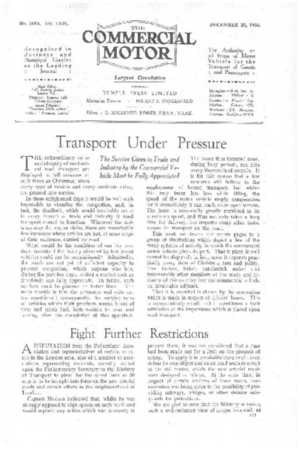Fight Further Restrictions
Page 17

Page 18

If you've noticed an error in this article please click here to report it so we can fix it.
A DEPUTATION from the Pedestrians' Asso ciation and representatives of certain councils in the London area, also of a number of associations representing residents, recently waited upon the Parliamentary Secretary to the Ministry of Transport to plead for the speed limit of 30 m.p.h. to be brought into force on the new arterial roads and certain others in the neighbourhood of London.
Captain Hudson indicated that, whilst he was strongly opposed to high speeds on such roads and would support any action which was necessary to prevent them, it was not considered that a case had been made out for a limit on the grounds of safety. To apply it in unsuitable cases might even defeat its own object and cause road users to revert to the old routes, which the new arterial roads were designed to relieve. At the same time; in respect of certain sections of these roads, consideration was being given to the possibility of providing subways, bridges, or other definite safeguards for pedestrians.
We are glad to note that the Ministry is taking such a well-balanced view of suggestions such as Du that put forward. The main object of arterial roads is to reduce congestion, and this can be achieved only by permitting a reasonable flow of traffic. Speed restrictions, if applied only at certain points, would have the definite effect of causing a piling-up of traffic and a congestion which would certainly become especially severe at busy periods.
It will be noted that the first name mentioned is that of the Pedestrians' Association. This body is constantly calling for restrictions against motorists, yet its membership is comparatively insignificant, and, in our view, it has no real right to speak with authority on behalf of those whom it is presumed to represent.
The C.M.U.A. Invitation to A.R.O.
THE announcement, which we were the first to publish last week, that the President of the Commercial Motor Users Association had been empowered to invite those members of the National Council of Associated Road Operators who are prepared to support the C.M.U.A. roadtransport policy, to be co-opted as members of the latter Council, is a surprising move which may bear sound fruit.
If the invitation be accepted by a considerable proportion of the A.R.O. Council, much good may follow, and possibly result in the forging of a stronger link in the scheme towards unity than would be the case if a merger containing many conflicting interests were to take place.
We know that many important members of the two associations concerned greatly regret the delays which have occurred, and the invitation should provide a bridge between them whereby the respective views of these two great bodies may be co-ordinated.
Curiously enough, in a leading article entitled "The Merger—Our Attitude," published on December 4, we suggested that there should be some form of welding under a common council, and the C.M.U.A. invitation is certainly a step in this direction. If successful, it will, in effect, constitute a merger of views, if not one of tact.
The official view of A.R.O. on the C.M.U.A. invitation has not yet been given, and the situation is, we understand, to be discussed at the next meeting of the Council, soon after the Christmas holiday.
In any case, the election of a new A.R.O. National Council is proceeding, and it seems probable that new members, who may find themselves in a position to serve both bodies, will be able to do much useful work in promoting good feel:ng and co-operation between these important associations.












































































